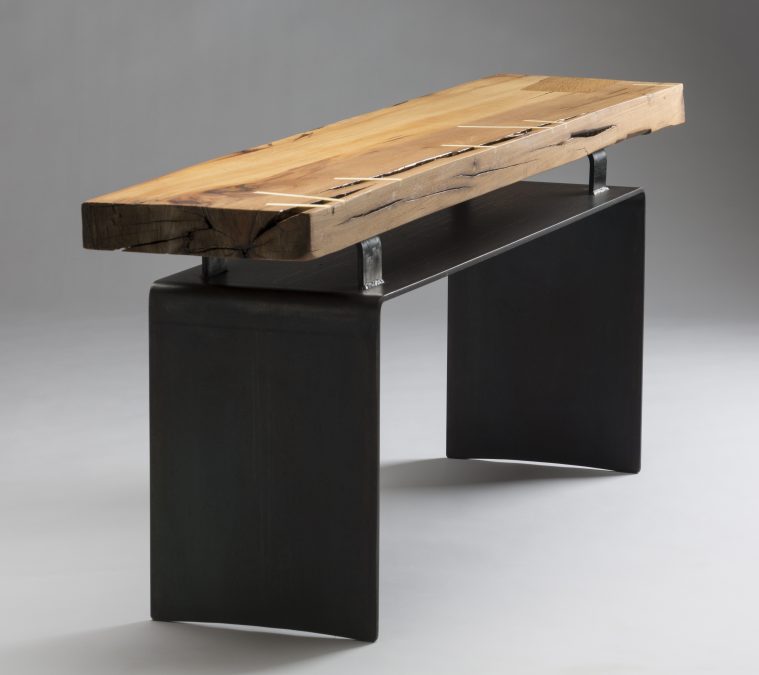Artifact/Deadfab co-owner Kevin “Cactus” Nemec fuses function and art with timeless handmade pieces made from wood and steel.
Over the last 15 years, local Steamboat artist and furniture maker Kevin “Cactus” Nemec has carved out a niche for himself—quite literally—from steel. But for the metal fabricator/furniture maker, his trajectory has been anything but traditional.
Nemec’s foray into welding was more like a slide, as in a rail slide. The former Steamboat Winter Sports Club snowboard coach wanted a portable rail for his team to be able to practice on, so he figured out how to make one. One thing led to another and soon Cactofab, his metal fabrication company, was born and he was building everything from skate parks to custom home finishes. But the real magic happened when he met his friend and business partner, woodworking artist and illustrator Brian Leach. Cactus describes their collaboration, Artifact/Deadfab as “a marriage between wood and steel.”
In a commitment to support local artisans, Steamboat Sotheby’s International Realty is proud to have a custom steel reception desk by Cactofab in our newly renovated mountain office. We caught up with Cactus to talk snowboarding, metal, and marriage.
Let’s start with your background. How did you end up in Steamboat? In 2002 I took an opportunity to work as head snowboard coach at Steamboat Winter Sports Club, so that got me up here. I wanted to make practice rails for my snowboard team that were portable, and that’s what got me interested in welding. It was kind out of necessity. I bought my first welder in 2002 and I’m all self taught. Soon I went from making snowboard rails and boxes to steel skate ramps and other park features.
How did you go from snowboarding and skateboarding to creating custom high end finishes for luxury homes? I taught myself how to do different kinds of patinas and acid finishes and transitioned into making custom artistic and decorative pieces for custom homes and fabricating architectural hardware, doing remodel work and doing pretty much everything but structural steel.
How did you segue into furniture design and how does metalworking fit into that vision? I met Brian Leach who’s an amazing wood relief artist and illustrator. He had the idea to build some steel furniture and I said, “That sounds like a great idea. Let’s do it!” It’s a great collaboration. He’s now my closest buddy.
What inspires you? Our goal is to figure out how to join the wood and steel intelligently rather than drilling a hole and sticking a bolt in it. Marry the wood and steel; that’s the basis for the design.
How would you describe your style? We don’t use any tubing. Everything is made from flats, bars and sheet steel. We figure out how to use hidden fasteners and old-world techniques so you don’t see a screw or a bolt. Brian will find all old reclaimed wood or old timbers that have a ton of character. Brian does different inlays with different species of wood. Or he’ll use colored fiberglass resin fillers, or wood burning or painting. So we’re trying to make pieces that are art first and then it has to work as furniture. A table or bench has to do its job, but it’s meant to be art. It should be proudly displayed as well used for something practical.
How are you able to work so closely with another artist? We have good creative friction. We’re on the same page but we are also brutally honest with each other. The honeymoon is long gone, but we butt heads in the best possible way. It forces us to come up with design concepts that both of us are willing to try. Our skills really compliment each other. It’s a great collaboration. We’re two artists who just can’t stop making stuff. We recently started making custom knives and now we’re thinking about building motorcycles.
What is your process? A big part of our design process is “anti”— trying to not do things that we’ve seen before. A lot of what we do is driven by trying to come up with something new and innovative, something we’ve never seen before. But it all begins with that marriage between steel and wood. The design process is really 50-50. One of us will start with a sketch and then convince the other person it’s a good idea. Then he’ll do woodwork and I’ll do steel work and then we’ll bring the two pieces together. We try to base our design on how they connect, both aesthetically and mechanically.
Tell us about the piece you did Steamboat Sotheby’s International Realty. We did a custom steel reception desk in the front lobby. There’s a feeling of permanence and a certain industrial appeal. Steel has a timeless design rather than something that’s going to fall out of favor down the road. Designers, contractors and homeowners somehow understand that 20 years from now steel is not going to be out of fashion. Steel has real staying power.

